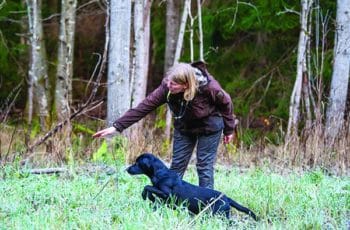Home infestations by mice and rats cause problems for millions of humans – but the poisons that are frequently used to control these incursions are deadly for our dogs. If you use rodenticides – chemicals that are used to kill mice, rats, voles, and other small mammals after they ingest the chemical – or if rodents are a problem in your neighborhood (and a neighbor might be using rodenticides), you should learn the signs of rodenticide poisoning and know what life-saving treatment is necessary if your dog consumes some of these deadly chemicals.
Rodenticides are added to food that will appeal to the rodents and formed into blocks and pellets. These baits have an attractive odor and taste to encourage the target animal to ingest the chemical, leading to his demise.
Dogs typically ingest rodenticide bait by chewing open a bait refill pouch or canister, chewing open a tamper-proof bait station, eating a bait that has been carried by a rat or mouse out of a bait station and then dropped, or eating a rodent that ingested rodenticide.
Rodenticides are regulated by the U.S. Environmental Protection Agency (EPA). The EPA has mandated that all rodenticide baits used inside the home by consumers be placed in a single-use or refillable bait station. Bait stations must be tamper-resistant to minimize the risk of exposure to children and pets.
Rodenticide bait refills are sold to consumers in resealable pouches or tubs. Unfortunately, these containers are not tamper resistant and must be stored where children and pets do not have access to them.
Dogs find rodenticide baits attractive for the same reason mice and rats do: They smell interesting and taste delicious. And because dogs are mammals, just like mice and rats, the active ingredient in the bait has the same mechanism of action in our dogs that it does in rodents.
Types of Rat and Mouse Poison: Symptoms and Treatment for Poisoning
There are three types of rodenticides available for purchase by consumers that can be lethal to our dogs: first-generation anticoagulants (warfarin, chlorophacinone, and diphacinone), bromethalin, and cholecaliferol (vitamin D3).
Anticoagulant rodenticides
These work by inhibiting an enzyme that activates vitamin K (see sidebar). In an animal who has eaten this poison, the initial clinical signs include bruising and petechia (red pinpoint hemorrhages, or dots, on the skin).
Without treatment, these clinical signs progress to coughing, vomiting, urinating and pooping blood, followed by uncontrolled internal bleeding and death. Since a dog’s body typically contains a small storage of activated vitamin K, it can take 36 to 72 hours following ingestion of an anticoagulant rodenticide to show clinical signs.
Treatment for dogs who are not showing clinical signs of anticoagulant rodenticide ingestion is straightforward. Your veterinarian will prescribe a course of vitamin K1 to be given for up to 30 days. The length of treatment depends on which anticoagulant was present in the bait. If your dog is showing signs of uncontrolled bleeding, he will need to be hospitalized to receive one or more blood transfusions and injections of vitamin K1.
Bromethalin
This is a neurotoxin that can cause tremors, seizures, and paralysis that progress to coma followed by death. Ingesting high doses of this rodenticide can cause clinical signs to appear within four to 18 hours of ingestion. Ingestion of lower doses may take one to seven days for clinical signs to manifest.
Bromethalin is metabolized by the liver into metabolites that are more toxic than bromethalin. Treatment for ingestion of this poison includes giving one or more doses of activated charcoal to bind the chemical and its toxic metabolites. If more than one dose is required, or your dog is showing neurologic signs, your veterinarian may recommend hospitalization of your dog to monitor and treat for seizures, tremors, and cerebral edema.
Cholecalciferol
This is better known as vitamin D3, an essential vitamin that helps maintain calcium and phosphorus balance in the body. Dogs lack the ability to synthesize vitamin D3 from exposure to sunlight (as humans do). Their daily requirement for vitamin D3 is met in the food they eat.
Cholecalciferol rodenticides deliver a toxic dose of vitamin D3. An overdose of vitamin D3 causes an increase in the calcium levels in your dog’s blood. This leads to mineralization of their internal organs and acute kidney injury. Even ingesting small amounts of bait can cause clinical signs. A toxic dose of cholecalciferol for a 50-pound dog is just one half of a one-ounce bait block.
Treatment for cholecalciferol ingestion includes giving one or more doses of activated charcoal and monitoring your dog’s kidney values and calcium and phosphorus levels once a day for three days post-exposure. Your veterinarian may recommend hospitalizing your dog for treatment of acute kidney injury if any of these values start to increase and become abnormal. If your dog starts to drink more water and urinate more and starts to vomit and not eat, then hospitalizing and treating for acute kidney injury may also be recommended.
Cholecaliferol can persist in your dog’s body for weeks following ingestion. If your dog becomes clinical for cholecalciferol toxicity, he may require weekly monitoring of his kidney values and calcium and phosphorus levels for three or more weeks. Dogs that have been hospitalized and treated for cholecalciferol toxicity can suffer a relapse of elevated calcium in the first few days following discharge from the hospital and need to be closely monitored.
Treatment for unknown poisons
Other rodenticides can be used by commercial pest exterminators or in agricultural situations. These include second-generation anticoagulants (brodifacoum, bromadiolone, difenacoum, difethialone), strychnine, and phosphide rodenticides. Second-generation anticoagulants are more potent than their first-generation cousins but the antidote is the same: administration of vitamin K1.
Bait stations are not required for baits located indoors where no children or pets have access (attics, for example) or that are buried below ground; unfortunately, baits that are packaged in easily chewed pouches or trays are all too often placed in cabinets or drawers that kids or pets find their way into.
The active ingredient of rodenticide bait cannot be determined by the bait size, shape, or color. If your dog ingests rodenticide bait and you do not know the active ingredient, then your veterinarian will need to treat for all three of the most commonly used residential rodenticides: anticoagulants, bromethalin, and cholecalciferol. Treating for one type of rodenticide exposure can be costly, but treating for all three types can be quite expensive!
Vitamin K1 and anticoagulant rodenticide toxicity
Vitamin K got its name from the German word “koagulation,” meaning to turn a liquid (like blood) into a solid or semi-solid (like a blood clot). Your dog’s liver (and yours, too!) produces clotting factors that are necessary to stop bleeding in the body. The liver needs activated vitamin K to make these clotting factors.
The process of making clotting factors oxidizes (deactivates) vitamin K. An enzyme called “vitamin K epoxide reductase” reduces (activates) vitamin K so that it can once again help to make clotting factors. Chemistry buffs will recognize this as an example of a reduction-oxidation, or redox, reaction.
Anticoagulant rodenticides inhibit this enzyme, leaving your dog with a whole lot of deactivated vitamin K that cannot be reactivated. That’s why your veterinarian will prescribe vitamin K1 to give twice a day; this is the activated form of vitamin K that your dog’s body needs to produce clotting factors.
If you have a rodent infestation
There are other methods for managing rodent home invasions, including sealing entry points in your home and the use of live capture traps. If you feel that you must use rodenticides in your home:
- Use only tamper-resistant bait stations as required by the EPA.
- Place bait stations only where your dog does not have access.
- Secure bait refills in a locked cabinet.
- Keep a binder containing information about all of the toxic products you use in your home. Add the rodenticide packaging information to this binder. If your dog ingests rodenticide bait, bring the packaging with you and your dog to the veterinary hospital.
Following these steps when using rodenticides will help to keep your family safe and minimize the risk of accidental exposure.


